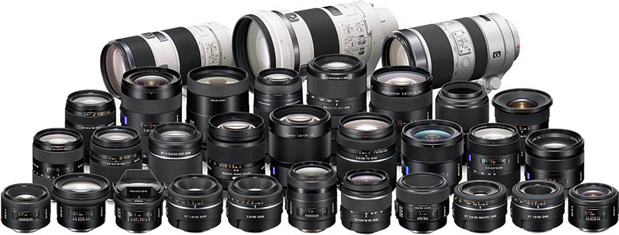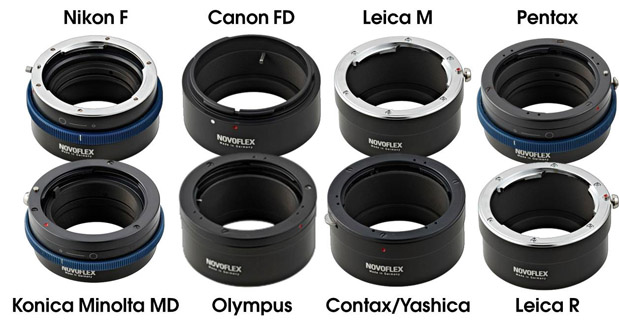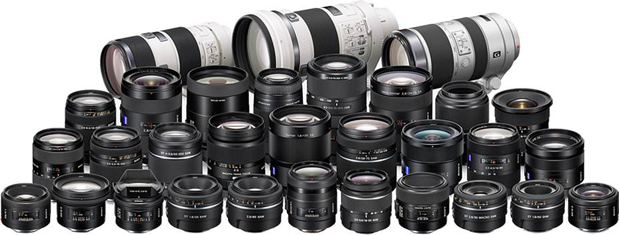
The NEX-FS100U accepts tons of lenses. For example, these Sony A Mount lenses work via the LA-EA1 adaptor.
It’s Cinematography 101: the right lens does more than establish the frame. It can help communicate emotion and tell us something about space, character and story. The ability to choose lenses is no small thing. Which brings us to the NEX-FS100U Super 35mm digital motion picture camera. Thanks to Sony’s E Mount system, the FS100U helps tell your story through a robust selection of lenses.
Little cameras. Big impact.
The NEX-FS100U offers a professional-grade, thermally-stable version of Sony’s E Mount system, with ruggedized, stainless steel construction. The E Mount system began when Sony developed the NEX Series mirrorless still cameras, the world’s smallest and lightest with APS-C sensors. To help keep these cameras as thin as possible, Sony decided on an unusually shallow 18 mm flange-back distance. Because the NEX Series is a runaway sales success, all sorts of third-party lens and accessory manufacturers are coming to the E Mount party. That’s opening up some delicious choices.
Whole lotta lens options.
The NEX-FS100U keeps the same 18mm flange-back distance but uses a professional Super 35mm sensor optimized for motion pictures. Because the two sensors are of comparable size, the huge inventory of lenses that cover the consumer sensor will also cover the professional sensor.
- Sony E Mount lenses. Of course the FS100U accepts native E Mount lenses directly. When mounted to the camera, these lenses offer auto focus, auto iris and in some cases an Optical SteadyShot image stabilization capability. Native E Mount lens offerings include the kit lens, an 18-200mm 11x zoom with ultra-quiet focusing motor and optical image stabilization (SEL18200). There’s an 18-55mm zoom (SEL1855) and a 16mm “pancake” wide angle (SEL16F28). A macro lens (SEL30M35) has been announced for availability in October.
- Third-party E Mount lenses. To help expand the E Mount universe, Sony has disclosed the system’s basic specifications and signed licensing agreements with third-party lens manufacturers Carl Zeiss, Cosina, Sigma and Tamron. In fact, Zeiss has already introduced native E Mount versions of their popular Compact Prime CP.2 lenses.
- Canon EF lenses. At NAB 2011, Birger Engineering announced and demonstrated a Canon EF to E Mount adaptor that supports both iris control and contrast detection auto focus from the camera. This will enable Canon system owners to use their prized collection of SLR lenses on a body that is optimized for motion pictures in ways that SLRs are not. Birger has yet to announce the adaptor’s price and availability.
- 35mm motion picture lenses. Because the E Mount flange-back distance is so short, accessory manufacturers have jumped in with E Mount adaptors that support motion picture lenses.
- Classic third-party still lenses. Many vintage lens series will cover the NEX-FS100U image sensor via third-party adaptors. The typical adaptor is a metal cylinder, devoid of optical elements, providing only the physical mount and the proper flange-back spacing. Adaptors support both SLR and rangefinder lenses. You can even use specialty lenses such as tilt-shift and bellows models.

The NEX-FS100U accepts classic still camera lenses, thanks to third-party E Mount adaptors.
- A Mount lenses. The Sony LA-EA1 adaptor enables you to attach more than 30 A Mount alpha lenses. These include such Sony G Lenses as the drool-worthy 135mm Smooth Transition Focus and 500mm Reflex, plus a selection of Carl Zeiss Distagon, Planar, Sonnar and Vario-Sonnar glass.
Some camera features make a difference on test patterns. Some make a difference in post production. The wide selection of lenses afforded by the NEX-FS100U makes a difference when you tell stories.

